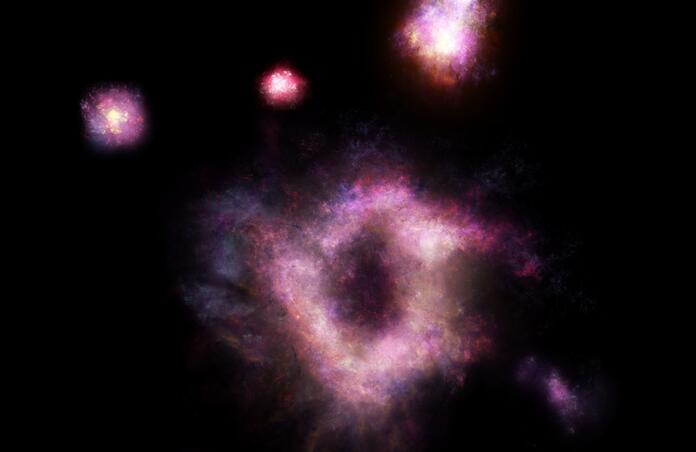Astronomers Discover Rare and Ancient ‘Ring of Fire’ Galaxy

A team of astronomers just discovered an incredibly rare 11-billion-year-old doughnut-shaped galaxy, nicknamed a ‘cosmic ring of fire.’
The galaxy, called R5519, has about the same mass as the Milky Way but is from the very early universe—over 11 billion light-years away. Most galaxies, especially ones from the early universe, are massive clusters or disks of stars huddled together. But the 'ring of fire' galaxy has a giant empty hole at its center, and it's larger than the supermassive black hole, M87. Until now, astronomers believed ring galaxies simply didn’t exist at that time, but this discovery is likely to challenge many hypotheses and theories about the formation of galaxies in the early universe.
R5519
The ‘cosmic ring of fire’ was discovered by a team of astronomers (hailing from Australia, US, Canada, Belgium, and Denmark) using spectroscopic data collected by the WM Keck Observatory in Hawaii and images from NASA’s Hubble Telescope. Their analysis of the galaxy, which was published in Nature Astronomy, revealed a great deal of information about its structure and type. They found that R5519's ring is over 42,400 light-years across, and the large hole at its center spans over 17,600 light-years.
R5519’s massive empty middle indicates it was formed as the result of an incredibly violent collision with another galaxy. Now, in the local (closer to the Milky Way) universe, collisional ring galaxies are already rare—about 1,000 times rarer than those that formed through internal processes. The number of circumstances that need to occur for another galaxy to pierce the center of a neighbor is astronomical. And, at 10.8 billion light-years away, R5519 is the first collisional ring galaxy ever found in the early universe.

The Milky Way & Beyond
The existence of R5519 holds a variety of answers to questions about the evolution and development of many other galaxy groups, including the Milky Way. A co-author of the study, Professor Kenneth Freeman from the Australian National University, states that "the collisional formation of ring galaxies requires a thin disk to be present in the 'victim' galaxy before the collision occurs. The thin disk is the defining component of spiral galaxies: before it assembled, the galaxies were in a disorderly state, not yet recognizable as spiral galaxies."
“In the case of this ring galaxy, we are looking back into the early universe by 11 billion years, into a time when thin disks were only just assembling. For comparison, the thin disk of our Milky Way began to come together only about nine billion years ago. This discovery is an indication that disk assembly in spiral galaxies occurred over a more extended period than previously thought.”